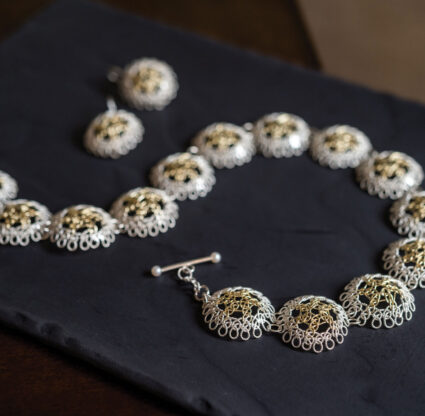Few pleasures in life match the first sip of coffee in the morning or the anticipation of a nice drink at the end of a long week. Only one cocktail manages to harness the power of both in a way that’s at once sophisticated and decadent—the espresso martini. The deceptively light, bitter-meets-sweet potion demonstrates serious staying power and a surge in popularity. In recent years, the caffeinated sipper has been among the most-ordered drinks nationwide, surpassing even the stalwart Manhattan in demand.
Yes, this is an ode to the espresso martini, a drink most records agree first entered the London bar scene in the 1980s and has since endeared itself to generation after generation of night owls looking for—as the legend euphemistically goes—something to wake them up and intoxicate them at the same time. Like low-rise jeans and bucket hats, the martinis may have fallen out of favor after the ’90s, but bartenders like Edgar Sierra, of District in Naples, say the cocktail is back and better than ever. “It’s the perfect after-dinner drink,” the recent New York City transplant says.
Traditionally made as a straightforward mix of vodka, espresso and chocolate liqueur, this elixir is shaken over ice to cool the coffee and create the signature foam. It’s all served handsomely in a martini glass. Often, three coffee beans top the drink to symbolize health, wealth and happiness. The cocktail has notably ridden the coattails of craft coffee crazes, and Southwest Florida—where third-wave coffee shops keep sprouting—is no exception.
These days, the libation comes in sophisticated iterations. “You’re used to what you’re used to until somebody comes and shows you something a little bit better,” Edgar says. Bicyclette Cookshop, where Edgar also works the bar, uses beans from Miami heavy-hitter Panther Coffee in their espresso martini. District’s espresso martini opts for cold brew, which has a more diluted flavor than fresh espresso and does not compete with the lighter flavor of the spiced Hawaiian rum the team subs in for vodka. Cheeky phrases are sprinkled on top with a stencil and cocoa powder.
Chartreuse Craft Cocktail Lounge, in Bonita Springs, riffs on the espresso martini similarly, but with a more local spin. Bar manager Rainier DeCastro uses cold brew made from Grumpy Goat Coffee Company beans, roasted down the road, on Old 41. The classic isn’t a favorite for Rainier (the cocktail has been around too long to excite his forward-looking team)—so he shakes the drink up into something more palatable for adventurous imbibers. Served in a chilled coupe, Chartreuse’s version mixes the nutty, earthy cold brew (instead of ice, which Rainier says dilutes the espresso) and weighty rum. The bar skips the three-bean garnish and instead goes with ground espresso sprinkled artistically on top. Rainier’s staff typically guides guests away from ultra-customized drinks. “This is an espresso martini—it’s not a latte martini. If you’re asking me for Bailey’s, then we’re going to make something different.” One substitution Rainier recommends? Tequila. “Because that’s just good,” he says.
Brittany Bowman, bar manager at Cape Coral’s Sage on 47th, notes that simplicity and using real, quality espresso are her keys to the kingdom—an espresso martini shouldn’t be an adult chocolate milk, she says. Sage uses a machine and beans from Lavazza, the roastery founded more than a century ago in espresso’s native land of Italy. For one of her spins, Brittany incorporates tequila and folds in cinnamon-infused simple syrup for a sultry, warm infusion.
At Beacon Social Drinkery at Fort Myers’ Luminary Hotel & Co., you can drink in the views of the Caloosahatchee River with your belle or beau from the rooftop lounge while sipping on Beacon’s light-on-caffeine tipple. Mr. Dean’s Martini—an homage to John Morgan Dean, an early Fort Myers real estate developer responsible for building up the nearby Dean Park—opts for espresso vodka and omits brewed beans. “There are so many expressions of spirits with coffee or espresso flavoring in it that you don’t always have to add the espresso itself,” Luminary general manager Jacob Larson says. Served in a martini glass or coupe, Mr. Dean’s Martini is garnished with three onsite roasted beans from the hotel’s Dean Street Coffee Roastery & Retail. Authentic espresso lovers fret not: The Luminary’s lobby bar makes a stellar traditional version. “Espresso martinis are just elegant and kind of sexy,” Jacob says.
Elegance defines drinks shared under the year-round twinkling lights of Naples’ Fifth Avenue South, where classic interpretations of the espresso martini reign supreme. At Caffè Milano, Dimitri Nikolov says their sumptuous staple remains ever-popular among the gals. Meanwhile, Sails owner Veljko Pavicevic goes all in on the most refined expression with the best ingredients he can procure. “We’re a little crazy,” Veljko says of his fanatic sourcing. “Until you taste it, you can’t really understand the reason for the madness.” Sails’ globe-trotting espresso martini aptly comprises award-winning Beluga Noble vodka from the Balkan country of Montenegro, sought-after Mr. Black’s bittersweet coffee liqueur from Australia, and espresso beans from Julius Meinl, a five-generation family-owned Austrian coffee roaster, dating to the mid-1800s. The garnish is always the same: three beans symbolizing health, wealth and happiness.





